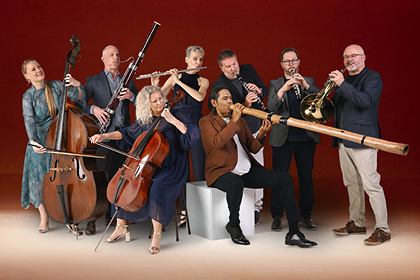The spirit of a yarn is about relationship: communication, communion, and reciprocity.
It’s this spirit which lies at the heart of Musica Viva’s upcoming tour of a very special program, which sees Ensemble Q and William Barton come together to showcase the affecting and transformative potential of collaboration. I had the recent pleasure of speaking with Paul and Trish Dean, co-artistic directors of Ensemble Q and clarinettist and cellist, respectively. I also had an inspiring discussion with William Barton, prolific yidaki player and singer, who joins Paul as a composer of the music converging in this program.
Described as a kaleidoscope of sound, the program reimagines chamber music for a modern and diverse audience. Paul and Trish talk of the ‘electric’ quality of live chamber music, with its immediacy and unique ability to foster intimacy with an audience. The program itself is an interface of cultures, histories and future possibilities, weaving shape, light and texture in harmonious tessellation. Works by Ligeti and Brahms, paired with works by Paul Dean and William Barton create a forward-thinking vision which opens up chamber music to the Australian landscape.
Ensemble Q is the love child of Paul and Trish Dean, and the current Company-in-Residence at Queensland Performing Arts Centre. Running since 2017, the ensemble consists of wind quintet, string quintet, piano, harp and percussion; an instrumental scope inviting endless types of repertoire. After a few minutes talking with the duo, I suspected that the ‘Q’ may stand for more than just their home base. The co-artistic directors reflected an ethos of questioning which permeates this ensemble; questioning the relevance of chamber music for modern contexts, and the potential ways in which chamber music might be exploited for new connections and complexities. Visually, in the letter Q lies the circle of communication, with the stroke of innovation taking them forward into the unknown.
I was curious to know how these four distinctive works fit together. That thread is the instrumentation- cello and wind quintet, which rarely assemble. The program was built around Paul Dean’s Concerto for Cello and Wind Quintet, and Brahms’ Cello Sonata in E minor, 'arranged to perfection’ as Paul says, by Heribert Brauer. Dean’s concerto was conceived in 2018 following his composition of his opera Dry River Run. Trish sees brushstrokes of the vocal writing carried through into her cello part in the concerto; ‘it sings with lyricism’, she says. Paul mentions the sense of expressive freedom found in the making of this work, calling it a 'work of great passion and love’ by someone 'madly in love with both the cello and the cellist’. As the music incubated on walks together, the compositional process felt like a documentary of his life with Trish.
‘I think this piece was, in many ways, the first piece that I really felt like was mine,’ he says.’
There is also beauty in the relationship between Ensemble Q and William Barton, whose work Journey to the Edge of the Horizon closes the curatorial loop. Paul and Trish both agree that William's music is about his virtuosity. This allows me to ask a question I love asking of musicians; one which is particularly pertinent to the classical sphere where ‘virtuosity’ is frequently mentioned: What does ‘virtuosity’ mean, to you? Trish answers first.
‘It’s like a really controlled party. The rigour needs to be there underlying the sense of adventure'.
For Paul, virtuosity is the swan, with its open-air grace concealing underwater labour; or a sports car, finely-tuned and controlled in the harness of the skilled driver, executing intention at every moment.
In my yarn with William, I want to better-understand his virtuosity, in his words. William Barton is a Kalkadunga man from Mount Isa in QLD, whose distinguished career as yidaki player, singer and composer has been transmitted intergenerationally and nurtured since childhood. Interestingly, like Paul, walking has played a key role in William’s creative process. In the modern day ceremony of walking, the artist explains. ‘I don’t just walk for myself; I walk for my people. I walk for my nation and I walk for all people that I open up that space to connect with.’ Connection is both in his cultural DNA, and in the creative intention for his work.
‘Journey to the Edge of the Horizon is me aligning my cultural heritage and legacy of the landscape with the modern world. I imagine bringing people to a space and time in that 17 minute performance- I want to take people there.’
I want to go there, myself.
William's piece is scored for yidaki, wind quintet, cello and bass, and also features him singing-; an alignment to the lyricism running through the cello part, and, I suspect, to Brahms and Ligeti, too. William also aligns notions of the traditional versus the contemporary which often come up in discourse around First Nations art. He doesn't hesitate to pull one or the other off their pedestal, to dissolve the sense of the line.
‘Who is to say what’s traditional and what’s contemporary? We’re nurturing the fragility of that fine line, which is like kangaroo sinew, of the Indigenous and non-Indigenous worlds.


